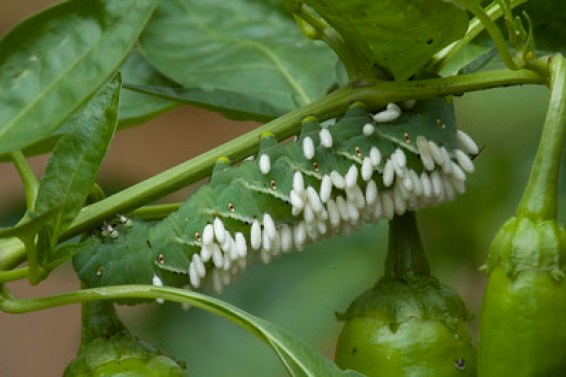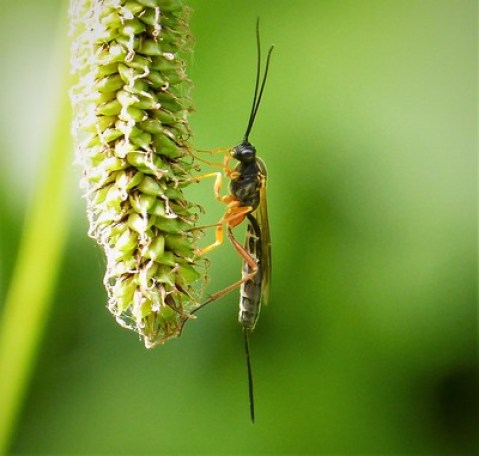¿Hablas español? Aquí esta una traducción: Control biológico de plagas: los parasitoides
Parasitoids are natural enemies of pests that, like predators (ladybugs and flower flies) can help us keep pest populations at bay or eliminate them from our gardens.
Parasitoid or parasite? Let’s learn the difference between these terms
Before saying more about this group of natural enemies, let me tell you that it is very common to confuse the term “parasitoid” with the term “parasite.” Parasites and parasitoids have in common the need for a host for their development. The difference between the two types of organisms is that parasitoids kill their host to complete their life cycle. That is, the parasite can live at the expense of the host without having to kill it, while the parasitoid ends up killing its host upon completion of its life cycle. Parasites are generally known to be annoying and even transmit diseases to animals, plants, and humans, while parasitoids are beneficial insects, as they help us control pests.
What is a parasitoid?
Parasitoids are insects that insert their eggs into the body or egg of another insect (host) in order to complete their life cycle. Parasitoids go through complete metamorphosis, four different stages of development: egg, larva, pupa, and adult. To finish their development, the parasitoids must feed on their host, and the females first deposit their eggs in their host. As soon as the parasitoid egg hatches, the larvae begin to devour the tissues of their host. Once the larvae reach a certain size, they become pupae, after which the adult emerges, killing the host.
Parasitoids can be classified according to their oviposition (egg-laying) behavior. Endoparasitoids are the parasitoids that lay their eggs inside the body or egg of their host. In contrast, ectoparasitoids oviposit on top of the body of their host, that is, on the surface of their body. To see these fascinating creatures in action you can, watch a video of endoparasitoids and one of ectoparasitoid activity.
Life cycle of an ectoparasitoid (adapted from Presa-Barra et al 2020)

Life cycle of an endoparasitoid (adapted from Presa-Barra et al 2020)

Some ways to identify signs of parasitism in our gardens
Observing parasitoid pupae on top of pests

Observing colonies of aphids

Diversity of parasitoids
Most parasitoids belong to flies (Diptera) and wasps (Hymenoptera). Thousands of species of parasitoids are known from both groups, with Hymenoptera containing the most identified parasitoid species.
Parasitoid flies: Tachinidae
Within the group of parasitoid flies, the Tachinidae are one of the most important groups for biological pest control. Most of these flies are larger than a housefly, 2mm-20mm. This group is very diverse and some Tachinidae are very hairy and dark in color, while others may appear pale to the naked eye, or have bright colors such as yellow or orange. Most Tachinidae are endoparasitoids. Tachinidae attack leaf caterpillars, fly larvae, adult beetles, and other pests much larger than themselves. In this video, you can see how a Tachinidae fly parasitizes a caterpillar.


Parasitoid wasps: Mymaridae, Braconidae, and Ichneumonidae
Parasitoid wasps are one of the most studied parasitoid groups for biological pest control.
The Mymaridae are a group of very small parasitoid wasps that specialize in parasitizing eggs. All members of this group of parasitoids parasitize eggs of bedbugs, beetles, and pest flies in our garden.

Ichneumonidae and Braconidae
These groups of parasitoid wasps are much larger than the Mymaridae. Most are around 1cm long, with 5cm being the record for the largest parasitoid wasps in North America, which belong to the genus Megarhyssa sp.
The Ichneuomonidae and Braconidae attack several pests including caterpillars, fly larvae, and aphids as shown in the image below.

Some of these parasitoids have a very long ovipositor, such as that of the species Megarhyssa macrurus, which is used to deposit its eggs in pests that are hidden between leaves or inside the trunk of trees. In this video, you can see Megarhyssa macrurus ovipositing on a tree trunk to attack a larva.

How to help parasitoids
There are several very effective practices for the conservation of parasitoids in our green spaces.
- As much as possible, avoid using broad-spectrum pesticides to control pests, as most of these also affect parasitoids. If you decide to use pesticides, opt for specific options and always use them as directed on the label.
- Diversify your planting (increase the types of plants grown) so that parasitoids have more spaces available to survive, a variety of prey to feed on, and/or nectar to supplement their diet. Crop diversification offers the presence of a wide variety of prey, which parasitoids can attack and use to survive when there are no pests in their green spaces. By increasing plant diversity, one provides parasitoids with resources that keep their populations in high numbers, which helps them better control our crop pests as soon as they appear.

In the case of a pest invasion, you also can acquire parasitoids in local insect hatcheries or on the internet and release them into your garden. This will lead to pest control and in some cases the establishment of those parasitoids in your garden, which can help fight future pests. It is important to note that for this to work, it is important to carry out the two other practices already mentioned above.
Find out more
Presa-Parra, E., Hernández-Rosas, F., Bernal, J. S., Valenzuela-González, J. E., Martínez-Tlapa, J., & Birke, A. (2021). Impact of Metarhizium robertsii on Adults of the Parasitoid Diachasmimorpha longicaudata and Parasitized Anastrepha ludens Larvae. Insects, 12(2), 125.
Patt, J. M., Hamilton, G. C., & Lashomb, J. H. (1997). Foraging success of parasitoid wasps on flowers: interplay of insect morphology, floral architecture and searching behavior. Entomologia experimentalis et applicata, 83(1), 21-30.
Wäckers, F. L. (2004). Assessing the suitability of flowering herbs as parasitoid food sources: flower attractiveness and nectar accessibility. Biological control, 29(3), 307-314.
By Darsy Smith, a Ph.D. student in the Department of Entomology at the University of Maryland, College Park. This article was published originally on the department’s Spanish-language blog, Extensión en Español.

You mention that “most parasitoids are very host specific”. This is not always the case – some generalist parasitoids will attack a range of closely related host species. This can be a problem when introducing parasitoids for biological control, as they may then attack non-pest species.
You also mention that “most parasitoids develop inside their host”. Again, this is not always the case – some external parasitoids lay their eggs on the outside of the host, and the larvae then burrow into the host to feed.
Finally, you state that “most parasitoids kill their host”. While this is true of many parasitoids, others (such as some members of the genus Copidosoma) are able to keep their hosts alive for extended periods of time while still reproducing inside them.
Great article! I’ve found a variety of these in my garden and when I do I’m always wondering who they’re going after or who they parasitized.